Metal- and Oxidant-Free Photoinduced Aromatic Trifluoromethylation Performed in Aerated Gel Media: Determining the Effects on Yield and Selectivity
Abstract
1. Introduction
2. Results and Discussion
3. Conclusions
4. Materials and Methods
4.1. Materials
4.2. Synthesis and Characterization of Compounds
4.2.1. General Remarks
4.2.2. Synthetic Procedures and Characterization of Compounds
4.3. Preparation and Characterization of Gel Materials
4.3.1. General Procedure for Gel Preparation
4.3.2. General Procedure for Intragel Reactions and Product Analysis
Author Contributions
Funding
Acknowledgments
Conflicts of Interest
References
- Otte, M. Size-selective molecular flasks. ACS Catal. 2016, 6, 6491–6510. [Google Scholar] [CrossRef]
- Timmermans, S.B.P.E.; van Hest, J.C.M. Self-assembled nanoreactors based on peptides and proteins. Curr. Opin. Colloid Interface Sci. 2018, 35, 26–35. [Google Scholar] [CrossRef]
- Shchukin, D.; Sviridov, D. Photocatalytic processes in spatially confined micro- and nanoreactors. J. Photochem. Photobiol. C Photochem. Rev. 2006, 7, 23–39. [Google Scholar] [CrossRef]
- Maldotti, A.; Molinari, A.; Amadelli, R. Photocatalysis with organized systems for the oxofunctionalization of hydrocarbons by O2. Chem. Rev. 2002, 102, 3811–3836. [Google Scholar] [CrossRef] [PubMed]
- Nakamura, T.; Son, A.; Umehara, Y.; Ito, T.; Kurihara, R.; Ikemura, Y.; Tanabe, K. Confined singlet oxygen in mesoporous silica nanoparticles: Selective photochemical oxidation of small molecules in living cells. Bioconjug. Chem. 2016, 27, 1058–1066. [Google Scholar] [CrossRef] [PubMed]
- Kagalwala, H.N.; Chirdon, D.N.; Mills, I.N.; Budwal, N.; Bernhard, S. Light-driven hydrogen generation from microemulsions using metallosurfactant catalysts and oxalic acid. Inorg. Chem. 2017, 56, 10162–10171. [Google Scholar] [CrossRef] [PubMed]
- Harris, C.; Kamat, P.V. Photocatalysis with CdSe nanoparticles in confined media: Mapping charge transfer events in the subpicosecond to second timescales. ACS Nano 2009, 3, 682–690. [Google Scholar] [CrossRef]
- Limones-Herrero, D.; Pérez-Ruiz, R.; Jiménez, M.C.; Miranda, M.A. Retarded photooxidation of cyamemazine in biomimetic microenvironments. Photochem. Photobiol. 2014, 90, 1012–1016. [Google Scholar] [CrossRef]
- Wen, J.; Ma, C.; Huo, P.; Liu, X.; Wei, M.; Liu, Y.; Yao, X.; Ma, Z.; Yan, Y. Construction of vesicle CdSe nano-semiconductors photocatalysts with improved photocatalytic activity: Enhanced photo induced carriers separation efficiency and mechanism insight. J. Environ. Sci. 2017, 60, 98–107. [Google Scholar] [CrossRef]
- Zhang, K.; Zhou, W.; Zhang, X.; Sun, B.; Wang, L.; Pan, K.; Jiang, B.; Tian, G.; Fu, H. Self-floating amphiphilic black TiO2 foams with 3D macro-mesoporous architectures as efficient solar-driven photocatalysts. Appl. Catal. B 2017, 206, 336–343. [Google Scholar] [CrossRef]
- Ghasimi, S.; Prescher, S.; Wang, Z.J.; Landfester, K.; Yuan, J.; Zhang, K.A.I. Heterophase photocatalysts from water-soluble conjugated polyelectrolytes: An example of self-initiation under visible light. Angew. Chem. Int. Ed. 2015, 54, 14549–14553. [Google Scholar] [CrossRef] [PubMed]
- Yamanaka, M. Urea derivatives as low-molecular-weight gelators. J. Incl. Phenom. Macrocycl. Chem. 2013, 77, 33–48. [Google Scholar] [CrossRef]
- Bachl, J.; Hohenleutner, A.; Dhar, B.B.; Cativiela, C.; Maitra, U.; König, B.; Díaz, D.D. Organophotocatalysis in nanostructured soft gel materials as tunable reaction vessels: Comparison with homogeneous and micellar solutions. J. Mater. Chem. A 2013, 1, 4577–4588. [Google Scholar] [CrossRef]
- Pérez-Ruiz, R.; Díaz, D.D. Photophysical and photochemical processes in 3D self-assembled gels as confined microenvironments. Soft Matter 2015, 11, 5180–5187. [Google Scholar] [CrossRef] [PubMed]
- Díaz, D.D.; Kühbeck, D.; Koopmans, R.J. Stimuli-responsive gels as reaction vessels and reusable catalysts. Chem. Soc. Rev. 2011, 40, 427–448. [Google Scholar] [CrossRef] [PubMed]
- Häring, M.; Pérez-Ruiz, R.; von Wangelin, A.J.; Díaz, D.D. Intragel photoreduction of aryl halides by green-to-blue upconversion under aerobic conditions. Chem. Commun. 2015, 51, 16848–16851. [Google Scholar] [CrossRef]
- Häring, M.; Abramov, A.; Okumura, K.; Ghosh, I.; König, B.; Yanai, N.; Kimizuka, N.; Díaz, D.D. Air-sensitive photoredox catalysis performed under aerobic conditions in gel networks. J. Org. Chem. 2018, 83, 7928–7938. [Google Scholar] [CrossRef]
- Bhat, S.; Maitra, U. Hydrogels as reaction vessels: Acenaphthylene dimerization in hydrogels derived from bile acid analogues. Molecules 2007, 12, 2181–2189. [Google Scholar] [CrossRef]
- Li, L.; Mu, X.; Liu, W.; Wang, Y.; Mi, Z.; Li, C.J. Simple and clean photoinduced aromatic trifluoromethylation reaction. J. Am. Chem. Soc. 2016, 138, 5809–5812. [Google Scholar] [CrossRef]
- Zhou, Y.; Wang, J.; Gu, Z.; Wang, S.; Zhu, W.; Acena, J.L.; Soloshonok, V.A.; Izawa, K.; Liu, H. Next generation of fluorine-containing pharmaceuticals, compounds currently in phase II–III clinical trials of major pharmaceutical companies: New structural trends and therapeutic areas. Chem. Rev. 2016, 116, 422–518. [Google Scholar] [CrossRef]
- Wang, J.; Sánchez-Roselló, M.; Aceña, J.L.; Del Pozo, C.; Sorochinsky, A.E.; Fustero, S.; Soloshonok, V.A.; Liu, H. Fluorine in pharmaceutical industry: Fluorine-containing drugs introduced to the market in the last decade (2001–2011). Chem. Rev. 2014, 114, 2432–2506. [Google Scholar] [CrossRef] [PubMed]
- Meanwell, N.A. Synopsis of some recent tactical application of bioisosteres in drug design. J. Med. Chem. 2011, 54, 2529–2591. [Google Scholar] [CrossRef] [PubMed]
- Kapoor, I.; Schön, E.-M.; Bachl, J.; Kühbeck, D.; Cativiela, C.; Saha, S.; Banerjee, R.; Roelens, S.; Marrero-Tellado, J.J.; Díaz, D.D. Competition between gelation and crystallisation of a peculiar multicomponent liquid system based on ammonium salts. Soft Matter 2012, 8, 3446–3456. [Google Scholar] [CrossRef]
- Li, Y.; Wang, T.; Liu, M. Gelating-induced supramolecular chirality of achiral porphyrins: Chiroptical switch between achiral molecules and chiral assemblies. Soft Matter 2007, 3, 1312–1317. [Google Scholar] [CrossRef]
- Hanabusa, K.; Yamada, M.; Kimura, M.; Shirai, H. Prominent gelation and chiral aggregation of alkylamides derived from trans-1,2-diaminocyclohexane. Angew. Chem. Int. Ed. 1996, 35, 1949–1951. [Google Scholar] [CrossRef]
- Carrillo, A.I.; Bachl, J.; Mayr, J.; Plaza-González, P.J.; Cátala-Civera, J.M.; Díaz, D.D. Non-invasive and continous monitoring of the sol-gel phase transition of supramolecular gels using a fast (pen-ended coaxial) microwave sensor. Phys. Chem. Chem. Phys. 2015, 17, 6212–6216. [Google Scholar] [CrossRef] [PubMed]
- Geng, H.; Ye, L.; Zhang, A.; Shao, Z.; Feng, Z. Ultrasound-induced gelation of fluorenyl-9-methoxycarbonyl-l-lysine(fluorenyl-9-methoxycarbonyl)-OH and its dipeptide derivatives showing very low minimum gelation concentrations. J. Colloid Interface Sci. 2017, 490, 665–676. [Google Scholar] [CrossRef] [PubMed]
- Nagib, D.A.; MacMillan, D.W.C. Trifluoromethylation of arenes and heteroarenes by means of photoredox catalysis. Nature 2011, 480, 224–228. [Google Scholar] [CrossRef] [PubMed]
Sample Availability: Samples of the compounds are not available from the authors. |
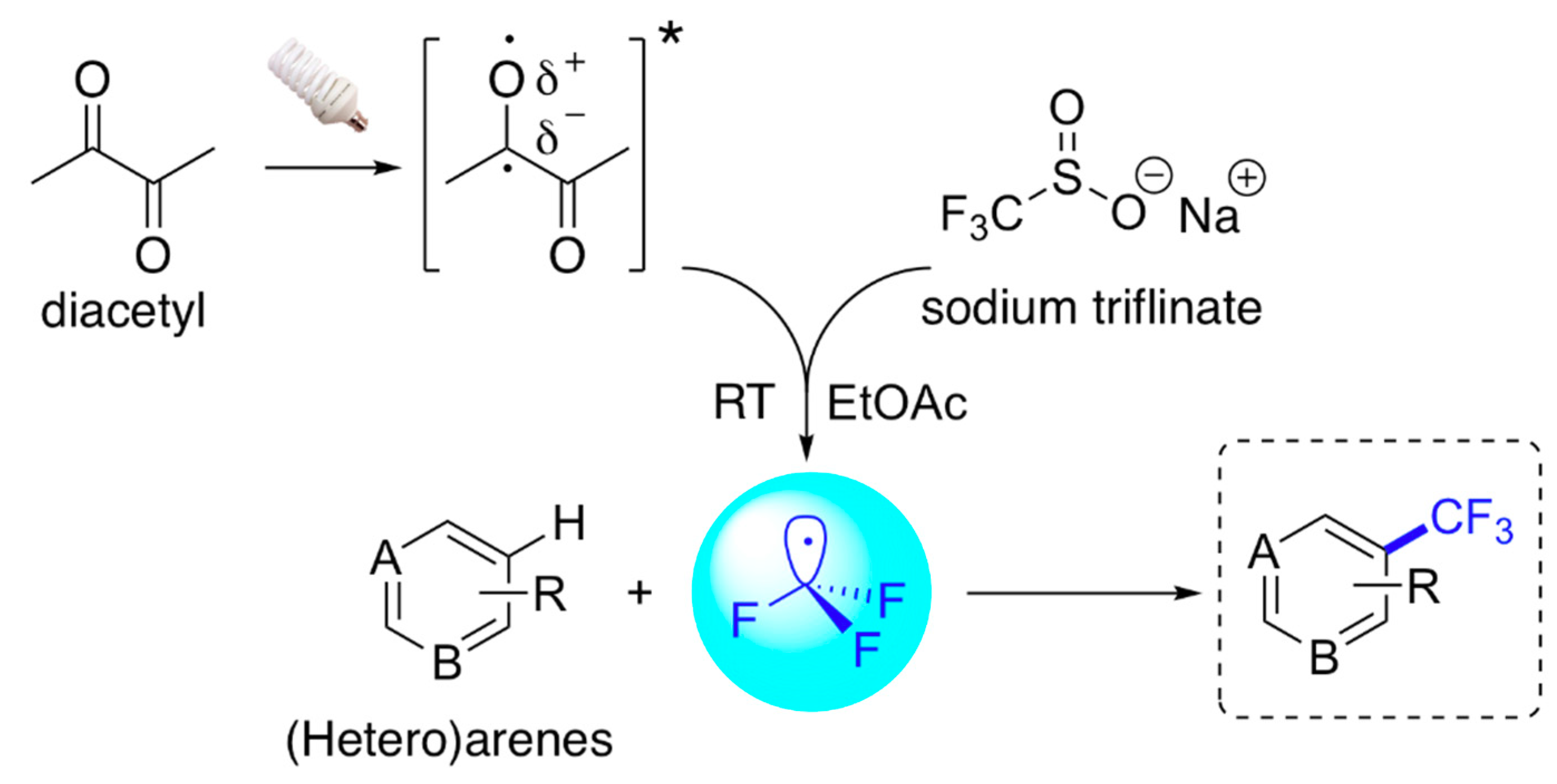
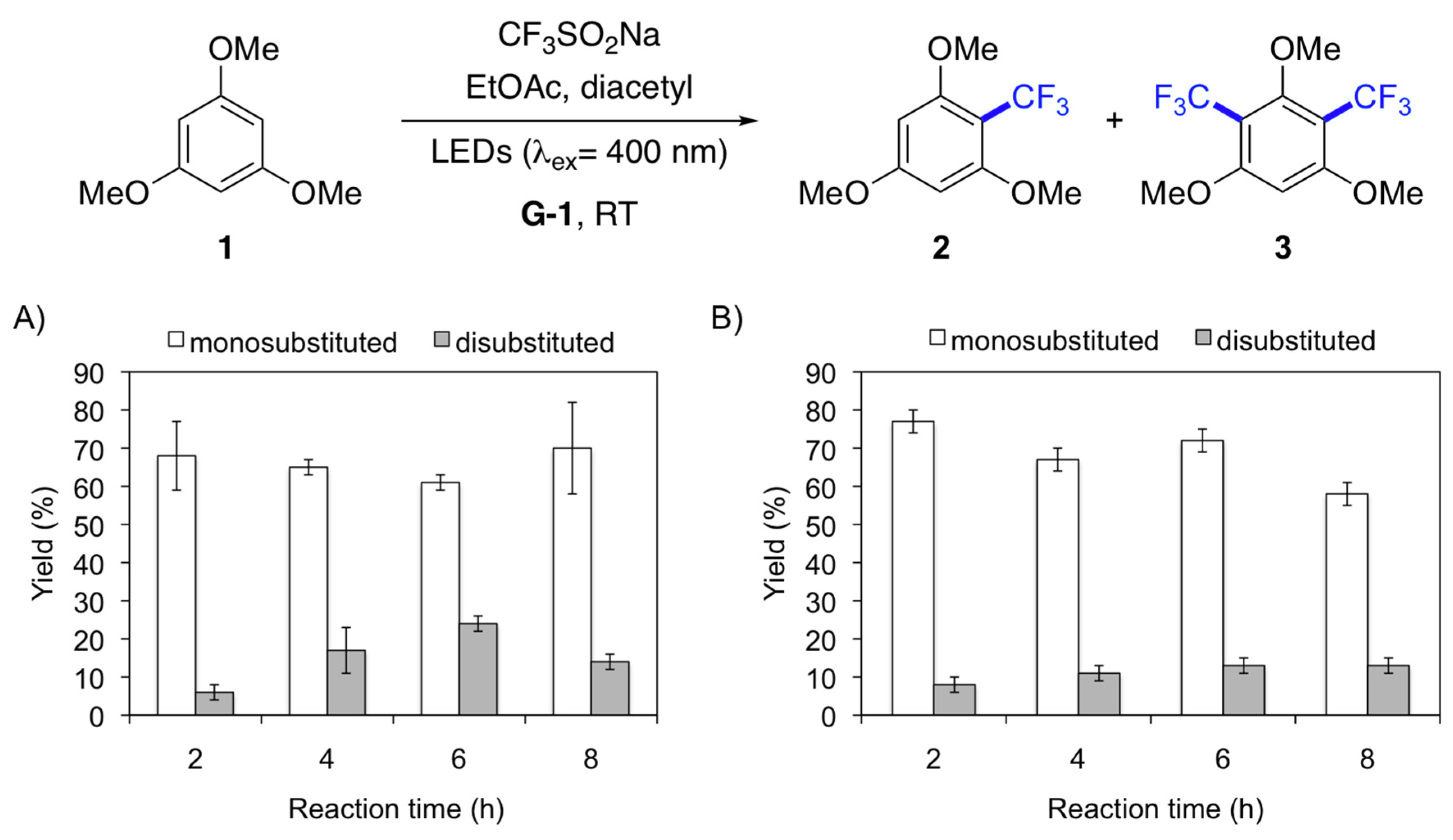
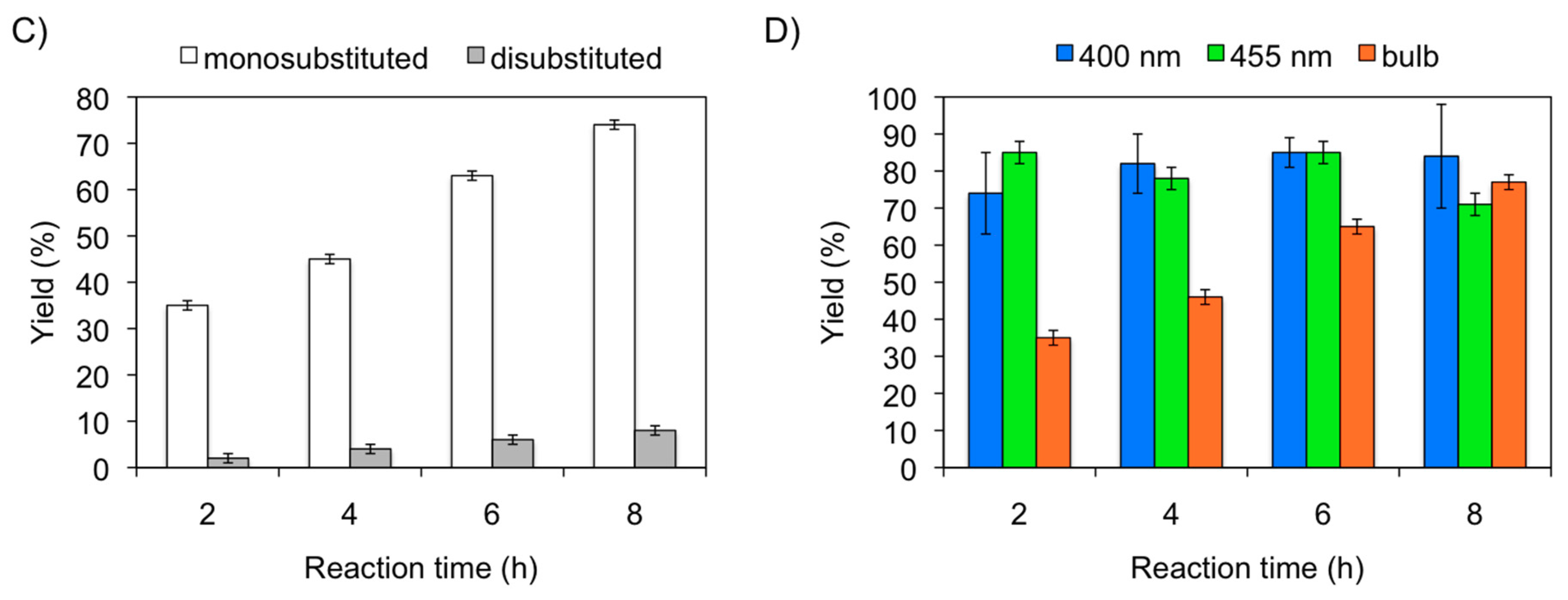
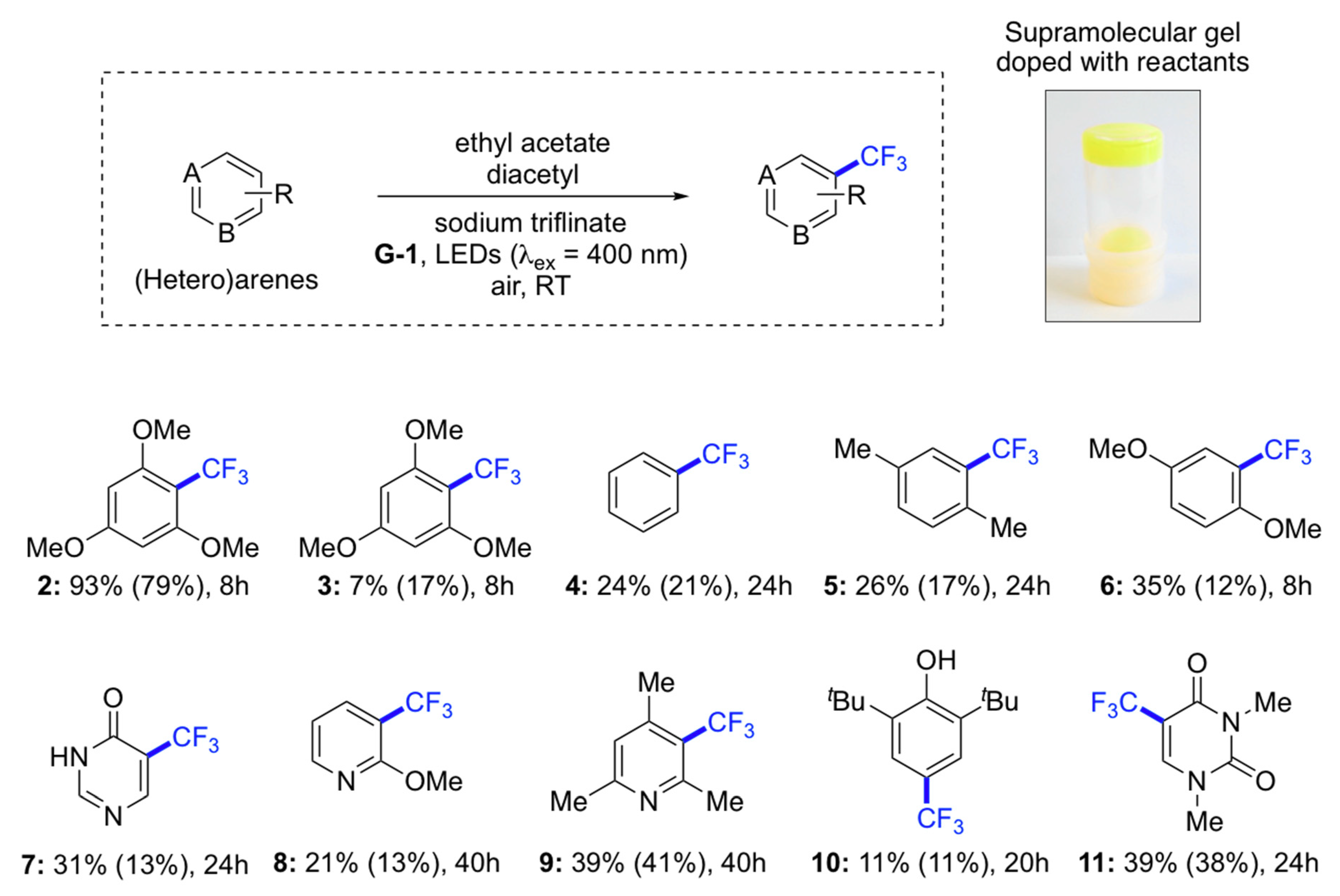


 | ||||
|---|---|---|---|---|
| Entry | Reaction Medium | Yield 2 (%) 3 | Yield 3 (%) 3 | Yield 2 + 3 (%) 3 |
| 1 | Solution, degassing | 79 | 17 | 96 |
| 2 | Solution, no degassing | 28 | 9 | 37 |
| 3 | Gel 2, no degassing | 61 | 24 | 85 |
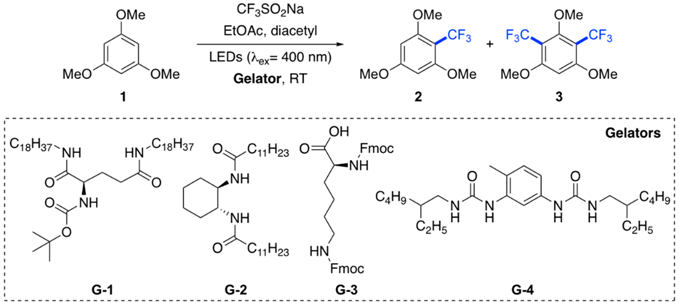 | |||||
|---|---|---|---|---|---|
| Entry | Gelator | Concentration (g L−1) | Yield 2 (%) 3 | Yield 3 (%) 3 | Yield 2 + 3 (%) 3 |
| 1 | G-1 | 20 | 61 | 24 | 85 |
| 2 | G-1 | 25 | 93 | 7 | 100 |
| 3 | G-1 | 30 | 73 | 19 | 92 |
| 4 | G-2 | 25 | 72 | 11 | 83 |
| 5 | G-2 | 30 | 79 | 14 | 93 |
| 6 | G-2 | 35 | 68 | 8 | 76 |
| 7 | G-3 | 60 | 52 | 2 | 54 |
| 8 | G-3 | 65 | 55 | 2 | 57 |
| 9 | G-3 | 70 | 50 | 2 | 52 |
| 10 2 | G-4 | 50 | 72 | 7 | 79 |
© 2018 by the authors. Licensee MDPI, Basel, Switzerland. This article is an open access article distributed under the terms and conditions of the Creative Commons Attribution (CC BY) license (http://creativecommons.org/licenses/by/4.0/).
Share and Cite
Abramov, A.; Vernickel, H.; Saldías, C.; Díaz Díaz, D. Metal- and Oxidant-Free Photoinduced Aromatic Trifluoromethylation Performed in Aerated Gel Media: Determining the Effects on Yield and Selectivity. Molecules 2019, 24, 29. https://doi.org/10.3390/molecules24010029
Abramov A, Vernickel H, Saldías C, Díaz Díaz D. Metal- and Oxidant-Free Photoinduced Aromatic Trifluoromethylation Performed in Aerated Gel Media: Determining the Effects on Yield and Selectivity. Molecules. 2019; 24(1):29. https://doi.org/10.3390/molecules24010029
Chicago/Turabian StyleAbramov, Alex, Hendrik Vernickel, César Saldías, and David Díaz Díaz. 2019. "Metal- and Oxidant-Free Photoinduced Aromatic Trifluoromethylation Performed in Aerated Gel Media: Determining the Effects on Yield and Selectivity" Molecules 24, no. 1: 29. https://doi.org/10.3390/molecules24010029
APA StyleAbramov, A., Vernickel, H., Saldías, C., & Díaz Díaz, D. (2019). Metal- and Oxidant-Free Photoinduced Aromatic Trifluoromethylation Performed in Aerated Gel Media: Determining the Effects on Yield and Selectivity. Molecules, 24(1), 29. https://doi.org/10.3390/molecules24010029






